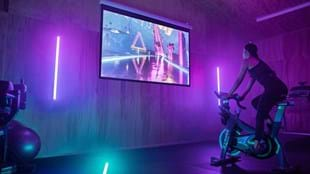Taking a class at the gym brings better results and more enjoyment than doing the same workout digitally at home, according to new research presented at the American College of Sports Medicine (ACSM) Conference this month (June 1).
Believed to be the first of its kind, the pilot study from the Les Mills Research Lab compared a traditional fitness class in a gym setting with home-based livestream and on demand sessions performing the same workout. Participants’ average heart rate was 14 percent higher during the gym class compared to the livestream and on demand sessions, despite being the exact same class format and release.
As well as motivating them to work harder, the gym-based workout was rated by participants as being 13 percent more enjoyable and 14 percent more satisfying than the two digital workouts.
Researchers believe the greater intensity and more positive perceptions of a gym-based class can be attributed to what they call ‘Groupness’. The term was coined after previous research from Penn State University found that people in live group exercise classes experience increased levels of individual exertion, enjoyment, and satisfaction as a result of exercising together in a studio, particularly when their movements are synchronized.
Dr. Jinger Gottschall, Adjunct Associate Professor at the University of Colorado and Lead Researcher for the study, said: “When considered with previous research, our findings show we really are social when it comes to working out – being together brings out the best in us.
“The combination of exercising as a group, led by an Instructor, in a gym studio setting, results in a more impactful and immersive workout than doing the same class at home via livestream or on demand. Having more fun and feeling connected also increases the likelihood of maintaining an exercise habit over a sustained period of time.”
Livestream (live classes on screen with both the instructor and other participants visible) and on demand (non-live, previously recorded classes on screen without other participants visible) workouts exploded in popularity during the pandemic, leading many to speculate that such digital fitness offerings could render gyms redundant.
But gyms across the world have made a strong recovery since lockdown restrictions eased, with many leading chains having already exceeded pre-pandemic occupancy levels as fitness fans flock back to live workout experiences.
“Although live classes are best for maximizing both physiological intensity and psychological perceptions, our research shows livestream and on demand fitness class formats are viable options for maintaining regular physical activity routines,” adds Bryce Hastings, Les Mills Head of Research and co-author of the study.
“In fact, study participants reported feeling less self-conscious and worried about their performance during the on demand workout, highlighting its potential as a gateway into regular exercise for newcomers who may not yet feel confident enough to join a live gym class.
“A live class at the gym remains the pinnacle experience, but the rise of digital fitness and flexible working reinforces the notion that hybrid fitness habits will become the norm. The 2021 Global Fitness Report found the majority of exercisers now favor a 60:40 split between gym and home workouts, so it will be interesting to see how fitness habits shift as the world learns to live with Covid.”
Methodology
Fifty-four regular BODYCOMBAT™ participants from five different gyms across the US wore a Bluetooth heart-rate chest transmitter during three experimental conditions (live in gym, livestream, on demand) for the same version of the workout in random order.
The live class was completed in a gym or studio, with all study participants from that facility present. The livestream class was completed at home with all study participants from that facility visible on screen. The on demand class was completed at home watching a previously recorded video with no participants visible on screen.
After each session, participants completed a survey containing questions related to rate of perceived exertion, enjoyment, and satisfaction.
ENDS
Media requests: press@lesmills.com
ABOUT LES MILLS
Les Mills is the global leader in group fitness and creator of 20 programs available in leading fitness facilities around the world. Les Mills programs include the world’s first group exercise resistance training workout BODYPUMP™, BODYCOMBAT™ (martial arts), RPM™ (indoor cycling), BODYBALANCE™ (yoga), LES MILLS GRIT™ (30-minute high-intensity interval training) and the revolutionary immersive cycle experience, THE TRIP™. Each workout is refreshed and updated with new choreography and music every three months.
The company was founded by Les Mills – a four-time Olympian and head coach of New Zealand’s track and field team – who opened his first gym in 1968 with the aim of taking elite sports training to the masses. Today, Les Mills workouts are delivered by 140,000 certified instructors in 21,000 clubs across 100 countries and are available as live, livestream, virtual and immersive classes, as well as via the LES MILLS+ streaming platform.


